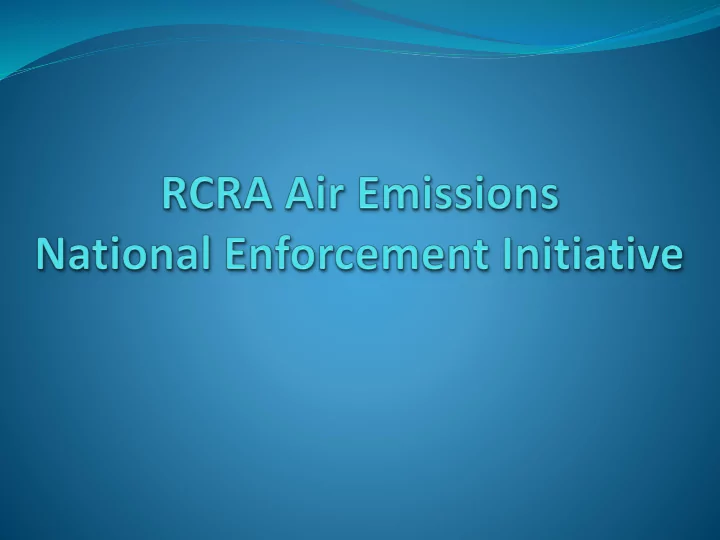

RCRA Air Emissions NEI Bring national attention to the importance of the control of hazardous waste air emissions from RCRA units. Ensure the use of a full range of tools for controlling hazardous/toxic air emissions. Minimize the potential for uncontrolled air releases of hazardous wastes into the environment. 2
Air Emission NEI Scope RCRA Subpart AA: Regulates RCRA hazardous waste treatment unit process vents. RCRA Subpart BB: Regulates RCRA hazardous waste valves, flanges, pumps, compressors, pipe runs and pressure relief equipment. RCRA Subpart CC: Regulates RCRA hazardous waste tanks, surface impoundments, and containers. This equipment must be appropriately designed, monitored, and maintained to appropriately detect and limit releases of hazardous waste to the air. 3
Risk Addressed with the RCRA Air Emissions NEI Direct threat to onsite workers from exposure to hazardous waste air emissions. Direct threat to nearby communities from exposure to hazardous waste air emissions. Potential for increased fire or explosion risk from organic air emissions. In addition to toxicity, volatile organic air emissions contribute to ground level ozone. 4
Inspection Scope and Focus Utilizing next generation compliance tools FLIR (Forward Looking Infrared) Camera PID (Photoionization Detector) Observation of tanks, containers, and ancillary equipment Records/Paperwork review 5
Ensure pipes are not resulting in releases of hazardous waste (BB) photo: R1 facility with RCRA AIR EMSSION CONTROL VIOLATIONS 6
Ensure other equipment is functioning properly (BB) photo: R1 facility with RCRA AIR EMSSION CONTROL VIOLATIONS 7
Ensure equipment vents control releases of hazardous waste (AA) photo: Region 6 Facility with CAA and RCRA AIR Emissions VIOLATIONS (SNC for RCRA and CAA) 9
Observations With regard to RCRA regulated equipment: Pressure relief valve emissions are a common problem; Run equipment to failure (obvious rust, corrosion, signs of poor maintenance); Facilities are not analyzing monitoring equipment failure trends Poor housekeeping 11
Common violations (national) Reviewed 36 completed RCRA Air settlements before and after start of the NEI. The cost common violations include: Improperly monitored / inspected equipment Equipment leaks / failure to seal equipment Failure to tag equipment Failure to maintain records The majority of the cases are not against CAA major sources 12
Hazardous Waste Generator Improvements Rule Revises the RCRA hazardous waste generator regulations to enhance flexibility, strengthen environmental protection, and improve compliance Final Rule was published Nov. 28, 2016, and went into effect May 30, 2017 https://www.epa.gov/hwgenerator s/final-rule-hazardous-waste- generator-improvements 13
HW Generator Improvements Rule Flexibility – CESQG consolidation by LQGs under the control of the same person. Allowance for episodic generation and maintenance of typical generator status.
Universal Waste – Aerosol Cans • Part of our broader RCRA Retail Strategy • Aerosol can management guidance • UW aerosol can regulations are expected to: 1. ease regulatory burdens on retail stores and other universal waste generators; 2. promote the collection and recycling of universal waste, and 3. encourage the development of municipal and commercial programs to reduce the quantity of these wastes going to municipal solid waste landfills or combustors. • Proposed rule published March 2018 15
Hazardous Waste Pharmaceuticals Rule Proposed sector-specific standards for the management of hazardous waste pharmaceuticals • Healthcare facilities/pharmacies • Pharmaceutical reverse distributors Proposed a ban on the sewering of hazardous waste pharmaceuticals from healthcare facilities and reverse distributors Took comment on de-regulating nicotine replacement therapies Currently finalizing the rule 16
Hazardous Waste Pharmaceuticals Rule (continued) Issues the rule intends to address 1. LQG status due to P-listed acute hazardous waste (i.e., nicotine replacement therapies) 2. Replace manufacturing-oriented framework with tailored, streamlined standards for healthcare facilities 3. Regulatory status of prescription pharmaceuticals that are sent to reverse distributors for manufacturers’ credit 4. Reverse logistics policy 5. Overlapping regulations with DEA 6. Flushing leftover pharmaceuticals 17
e-Manifest Overview Allows industry to electronically submit uniform hazardous waste manifest forms to the EPA Allows for nationwide public access to manifest data System Launch June, 2018 Anticipated Result Through reducing burden of the paper-based process, e-Manifest is expected to save more than $90 million per year for states and industry. 18
Contact Info Larry L. Lamberth Chief, Enforcement and Compliance Branch Resource Conservation and Restoration Division EPA Region 4 404-562-8590 Lamberth.larry@epa.gov
Recommend
More recommend